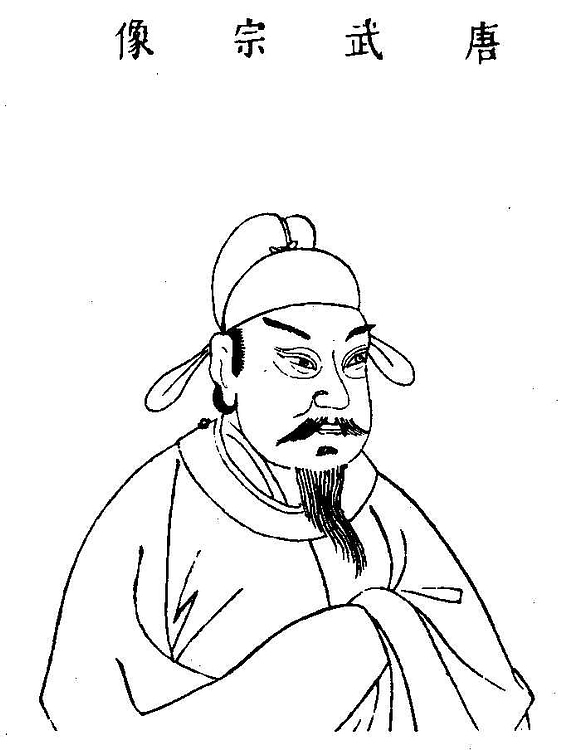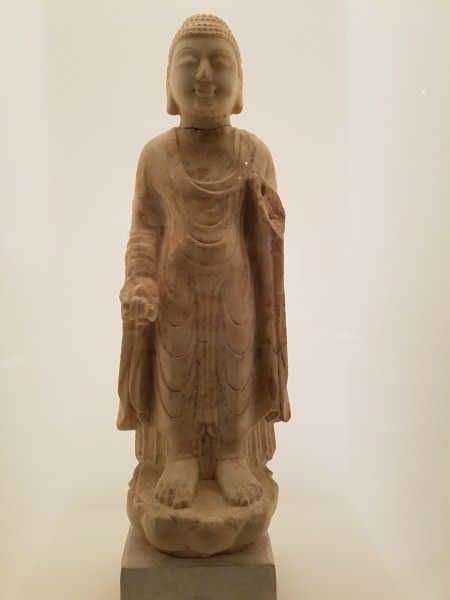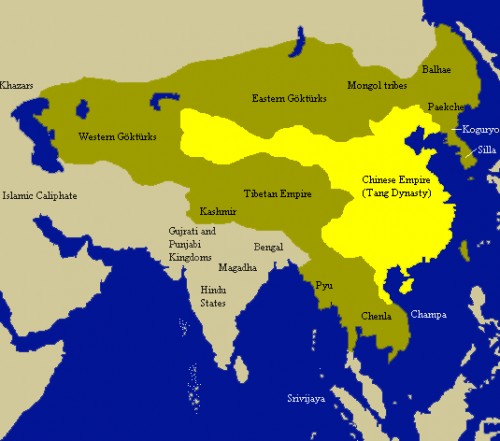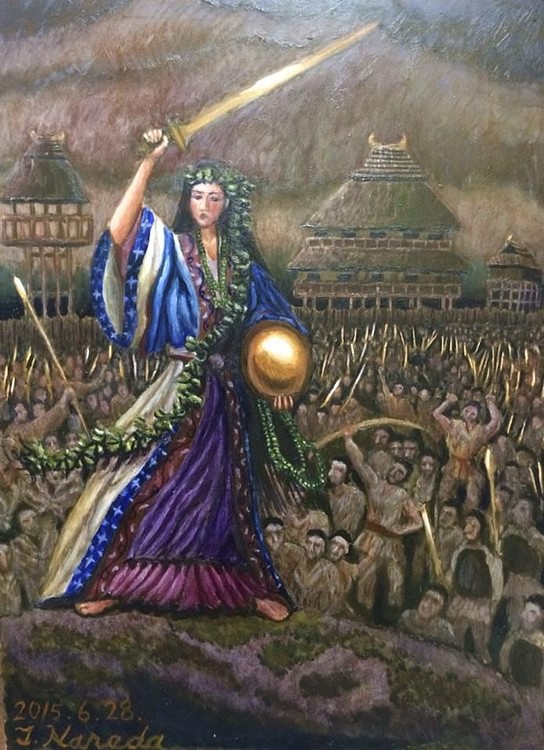Wuzong of Tang › Queen Himiko » Ancient origins
Articles and Definitions › Contents
- Wuzong of Tang › Who Was
- Queen Himiko › Who Was
Ancient civilizations › Historical and archaeological sites
Wuzong of Tang › Who Was
Definition and Origins

Wuzong of Tang (also Wu-Tsung, formerly Li Yan) reigned as emperor of China from 840 to 846 CE. He is best remembered today for his persecution of Buddhists, the worst such attack in all of China's history, and his early death by insanity from drug abuse. Wuzong, nevertheless, did manage to steer the Tang Dynasty clear of the excessive political in-fighting and eunuch dominance which had plagued the courts of his predecessors.
POLITICAL ACHIEVEMENTS
Wuzong was born in 814 CE, the fifth son of Emperor Muzong (r. 820-824 CE). He was the younger brother of his predecessor, Emperor Wenzong (aka Wen-tsung, r. 827-840 CE) and held the title Prince of Ying before his succession. He gained the throne because Wenzong's own son had died in mysterious circumstances in 838 CE. Wuzong also had the full support of the court eunuchs, the powerful group who dominated Chinese politics. His character and style of rule is here summarised by the historian MT Dalby,
...the emperor was brash, quick-tempered and stubborn. But, unlike his elder brother Wen-tsung, he was also shrewd and decisive. Like a number of his predecessors, religion gripped him as much as politics. To the family weakness for alchemical experimentation in search of immortality, he added a genuine interest in Taoism.(Twitchett, 663).
The emperor found another able ally in his chief minister Li Deyu (787-850 CE). Deyu had been briefly exiled in a previous reign and he would be exiled in a future one but Wuzong seemed to appreciate his talents. Together they were able to reduce the political factionalism which had long beset the Tang court and even to reduce, bit by bit, the influence of the eunuchs who had long abused their privileged position within the palace, controlling who had access to the emperor and profiting from it.
WUZONG WAS COMMITTED TO REDUCING THE POWER OF BUDDHIST MONASTERIES BY CLOSING MANY OF THEM DOWN & REVOKING THE LICENSES OF A LARGE NUMBER OF PRIESTS.
Deyu's strategy of government was to reduce the involvement of all chief ministers, who had been notoriously argumentative in discussions of policy under the previous emperor. Instead Deyu took all major decisions himself in consultation with the emperor and removed the debates and consequent factions which had traditionally been a part of Tang government. As he put it himself, government decisions should “issue forth from a single gate” (Twitchett, 661). Deyu did make some of his own loyal followers aides with junior positions but he also resisted the usual purge of the court which followed every new succession.Another feature of the new regime was the meticulous keeping of public records for all official communications, meetings and decisions.
PERSECUTION OF BUDDHISM
Wuzong was a committed Taoist so his infamous persecution of Buddhism between 842 and 845 CE was one of conscience, even if there were also good political motives and sound economic arguments for curtailing the ever-increasing power of the Buddhist monasteries. The temples were seen by the state more as a place of refuge for those avoiding their tax and civic obligations than a retreat for genuine scholarly and religious contemplation. Unlike its two greatest rivals of Taoism and Confucianism, Buddhism was widely seen as a “foreign” religion and not necessarily a wholly beneficial one for the Chinese state. Neither was the amassed wealth from its land ownership, accumulated gifts, and tax exemption, or the frequent support for those suffering from government policies or mismanagement ever likely to endear Buddhist monasteries to the authorities.This was especially so when the coffers of the Tang court were now so impoverished. Finally, many Buddhist leaders received such a cult following that they and their secret societies sometimes threatened local authority.

Tang Dynasty Standing Buddha
The attacks were not without their critics but Wuzong was committed to reducing the power of the monasteries by closing many of them down and revoking the licenses of a large number of priests. The first monks to go were any who had married, practised medicine or otherwise flouted monastic rules. Next to be targeted were members of the Manichean clergy, which was closely associated with the troublesome neighbouring tribe the Uyghurs (see below). There followed over the next few years a procession of government edicts designed to frustrate and repress Buddhism in China from forbidding the worship of certain relics to the systematic destruction of sacred texts and artworks.
By 845 CE the state was taking even more drastic measures against all things Buddhist such as confiscating monastery-held lands and purging individuals listed on a census specially compiled for that purpose. By the end of it, 4,000 monasteries and 40,000 small rural temples and shrines had been destroyed. 250,000 monks were stripped of their monastic status and countless gold, silver and copper relics were seized and melted down. The persecution only came to an end with Wuzong's untimely death but it was too late, even then, and the Buddhist monasteries would never regain their lost wealth and power in China.

Tang Empire & Neighbouring States
BORDER THREATS
Besides troubles from within, Wuzong also faced trouble from without. Nanzhao, an independent tribute kingdom in the south-west (modern Yunnan province), had already shown its territorial ambitions by attacking Chengdu in 829 CE and it continued to push its claims during Wuzong's reign. Another problem state was that of the Turkic Uyghurs to the north (in parts of modern Inner Mongolia) who similarly sought to redraw their border with China having lost much of their territory to the Kyrgyz nomadic confederation. In 840 CE more than 100,000 of the nomads gathered on China's borders near the Huang-ho river. The immediate necessity was for the Chinese to bolster their border defences and build new fortresses. They also increased the armed forces in the area which had been left depleted in recent decades. In 843 CE the Chinese made their move and attacked the Uyghur camp before pursuing the enemy into the Gobi desert where 10,000 tribespeople were killed and 20,000 taken captive. A mountain at the site of the massacre acquired the name of Sha-hu shan or “Kill-the- Huns Mountain”.
In both cases the emperor was, then, with the help of Li Deyu, eventually able to successfully defend the status quo. Deyu, as a reward for his campaign against the Uyghurs and his repression of a rebellion in Zhaoyi (Chao-i) province, was made a Duke of Wei in 844 CE.
DEATH & SUCCESSOR
Wuzong died in 846 CE aged just 33. The cause of his premature death was likely insanity either directly caused, or at best worsened, by drug abuse in his quest to discover the elixir of life - concoctions made up from the hearts and livers of children if Buddhist sources are to be given credence. As Wuzong's own sons were deemed too young to take the throne he was succeeded by his uncle, Emperor Xuanzong (r. 846-859 CE) who, notably during his reign, reversed the persecution of Buddhists.
Queen Himiko › Who Was
Definition and Origins

Queen Himiko, also known as Pimiko or Pimiku (183? - 248 CE), was a 3rd-century CE ruler of the territory in ancient Japanknown as Hsieh-ma-t'ai or Yamatai, later to be known as Yamato. Considered by the Chinese as the ruler of all of Japan or Wa, given her state's power, she exchanged diplomatic embassies with the ruling W|ei dynasty. A semi-legendary figure, Himiko is curiously absent from Japanese historical records but does appear briefly in Chinese histories. The queen was noted for being a shamaness, unmarried, and living in a fortress where she was served by 1,000 women.
YAMATAI
Himeko's name in archaic Japanese means Sun Child or Sun Daughter and probably alludes to her divine descent from Amaterasu, the Shinto sun goddess, as all Japanese rulers would later be identified as being descendants of. Scholars do not agree on the exact location of Queen Himiko's state Hsieh-ma-tai/Yamatai. A minority place it in north Kyushu, but the majority consider the Nara region as the most likely candidate. In Japan, at the time of her reign during the 3rd century CE, there were around 100 kingdoms spread across the islands. It seems that Himiko's state was the most powerful of these and may have led a loose federation of 30 states as the contemporary Chinese state recognised her as, in effect, the ruler of all of Japan.
SCHOLARS CONTINUE TO DEBATE WHO HIMIKO WAS, WHERE SHE MIGHT HAVE RULED & WHAT IS THE LOCATION OF HER FABLED BURIAL MOUND BUT WITHOUT ANY CONSENSUS EVER BEING REACHED.
HISTORICAL REFERENCES
Queen Himiko's role as a shamaness or high priestess, not an uncommon practice for rulers in early East Asian cultures, is alluded to in the Chinese history book Wei Chih ('History of the Kingdom of Wei') which was written in 297 CE. There, we are told Himiko "occupied herself with magic and sorcery, bewitching the people" (Henshall, 152). Japanese dynastic histories such as the Kojiki ('Record of Ancient Things'), compiled in 712 CE, and the Nihon Shoki ('Chronicle of Japan' and also known as the Nihongi), compiled in 720 CE, do not mention Queen Himiko by name. It is recorded in the Nihon Shoki that the Queen (although not named) sent a tributary embassy to the Wei kingdom of China in 238 CE:
In the sixth month of the third year of Ching-ch'u [238 CE] in the reign of Emperor Ming Ti, the queen of the Wa sent the grandee Nashonmi and other; they visited the prefecture and asked permission to proceed to the emperor's court and present tribute. The governor, Teng Hsia, dispatched an official who escorted them to the capital. (Keene, 72)
Following this embassy, the Chinese gave Himiko the honour of the title 'Queen of Wa, Friendly to Wei' and a gold seal. Other gifts given to the queen in return for her tribute of fine cloth and slaves to the region's great power included beads, 100 bronze mirrors, and swords, some items of which may have become part of the Japanese imperial regalia. Himiko sent two more embassies to China in 243 and 247 CE. For all these good relations there would not be any more contact between the two states until the Sui Dynasty of the 7th century CE.

Three Kingdoms Period of China and the Rise of Xianbei in the year 229 CE
BIOGRAPHICAL DETAILS
According to the Wei Chih, Queen Himiko was chosen by her people following a turbulent period of 70 or 80 years beset by uprisings and warfare. Although enjoying a peaceful reign, the queen was said to have never married and lived as a recluse in a mighty towered fortress which was guarded from the outside by 100 men. Inside, the monarch was served by 1,000 female servants. Himiko did have one male attendant who served her food and acted as her point of contact with her kingdom and other states. She also left affairs of state to or at least shared them with her younger brother while she devoted herself to shamanism.
It may be that this romantic description of seclusion and leaving politics to her brother is the result of author bias - it was common for Japanese rulers not to receive ambassadors, for example, which would lead Chinese visitors with the impression of a retiring monarch and later (male) writers were keen to establish a male-only line of sovereigns on the Japanese throne.
When Himiko died in 248 CE, it is said that she was interred in a tomb measuring 100 'paces' (equivalent to 150 metres) and that 100 slaves were sacrificed in her honour. With her death, Japan moved from the Yayoi Period (c. 300 BCE - c. 250 CE) to the Kofun Period (c. 250-538 CE).
LEGACY
Scholars continue to debate who Himiko was, where she might have ruled and what is the location of her fabled burial mound but without any consensus ever being reached on all three points. The ancient queen also continues to appeal to the imagination of the wider Japanese public and is easily the most recognisable name in history for the majority of Japanese school children. With regional beauty contests being held in her name, Tarot cards featuring her image, and manga comics starring the queen in various guises ranging from an erotic character to a symbol of female rulership, the legend of Himiko is sure to live on for a good while yet.
This article was made possible with generous support from the Great Britain Sasakawa Foundation.
LICENSE:
Article based on information obtained from these sources:with permission from the Website Ancient History Encyclopedia
Content is available under License Creative Commons: Attribution-NonCommercial-ShareAlike 3.0 Unported. CC-BY-NC-SA License